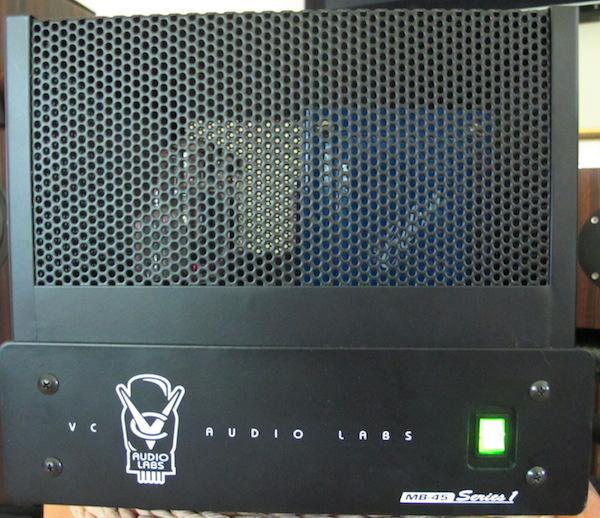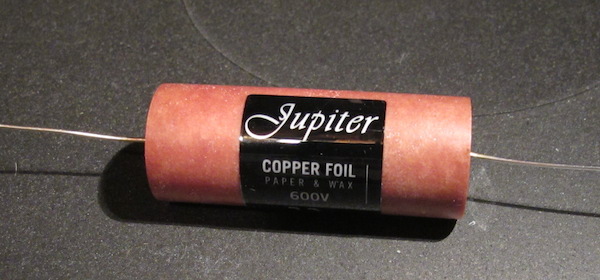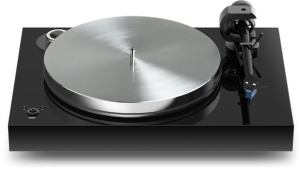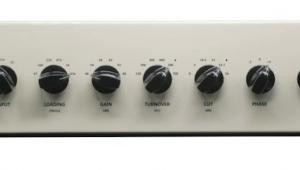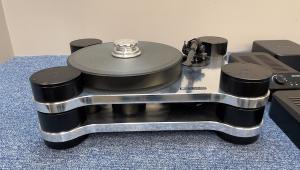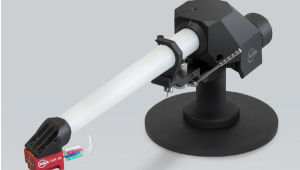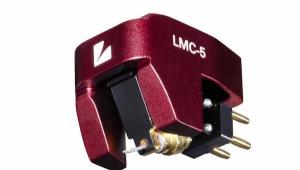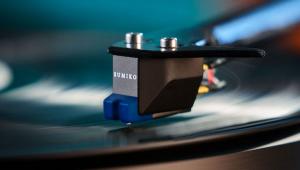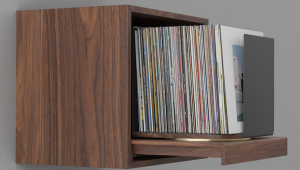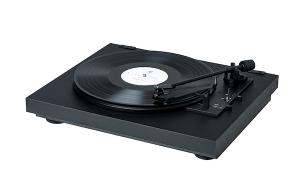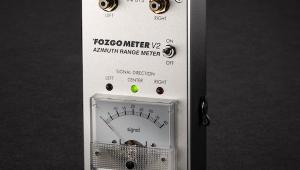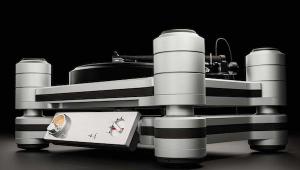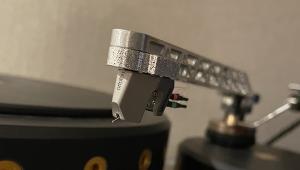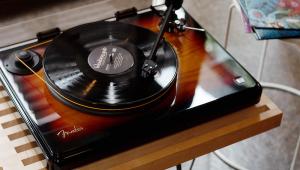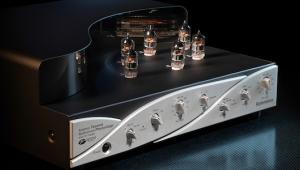The VC Audio Labs MB-45 KT120 Monoblock Power Amplifier Kit (Manufacturer's Comment Added)
So you could say this new amp kit costs about twice as much as the Dynakit but that wouldn't really be a fair comparison. For one thing, back then tube amps weren't at all exotic. They were the only amplification game in town so unlike today, parts and tubes were commonplace. Let's stop there with the comparison.
This website is really about vinyl records and associated gear. We don't cover tube amplifiers but in this case we made an exception. For one thing, the very first product reviewed here was of the made-in-Detroit Anvil turntable, so with this company's products and Anvil's you could put together 2/3s of a complete system all made in Detroit. Maybe Shinola could design and market a loudspeakers and then there could be an all-Detroit audio system. We're all for a Motor City comeback. We agree with Martha of Martha and the Vandellas who sang "Don't forget the motor city".
So when the folks at Oddwatt Audio contacted me a few months ago about reviewing one of their kits I couldn't say "no." One thing I wish the company would do is make up its mind about the name. The instructions call this amp the "VC Audio Labs MB-45", while the Oddwatt Audio website and the chassis say it's the Oddblock High Output Series 1. Whatever it's called—and I'll let them explain should they choose to respond—these are high quality, point to point wired amplifiers (with you doing the wiring) featuring American-made transformers and other internal components residing in solid steel chassis.
The deceptively simple circuit uses a single NOS (new old stock) 12SL7GT driver tube and a pair of Tung Sol KT120 output tubes in a configuration the company calls unique and that skeptics said "couldn't work" but clearly does. The claim is for 45 watts of class "A" power (the circuit uses a constant current source output stage) at less than 2% THD. If the tech talk glazes over your eyes, ignore it. But don't ignore that these amps are claimed to be flat to 10Hz and capable of driving extremely difficult loads such as highly capacitive electrostatic speakers.
Because the amps use octal-base tubes, with just a flick of a switch and an easy to perform tube balancing, you can swap out the KT120s for 6550s, KT88s or KT90s. Output lowers to as low as 25 watts but in many circumstances that's more than sufficient power.
A built pair was sent because I just don't have time right now to wire a pair though I'm damn good with a soldering iron—I once built a Heathkit vacuum tube based color television that was also all point-to-point wiring and a lot more complicated than are these amps. It took an entire summer to build and then align using the built-in test gear but once finished it was the best looking color TV I'd ever seen. A week later our house was robbed.
As is often the case with smaller and start-up companies, the packaging was less than ideal (which is being kind) but considering what you get for your money as long as the amp arrives in one piece (plus assorted pieces). who cares?
Set Up
Once you're amps are put together you insert the three tubes and follow the instructions, which are excellent and far superior to the packing. Connect your speakers to the 5 way binding posts, selecting either the 4 ohm or 8 ohm taps and flip the power switch. Since it's a kit you will have built:
IF YOU SEE SMOKE, A FLASH OR ANYTHING THAT LOOKS ODD UNPLUG THE UNIT IMMEDIATELY AND CHECK FOR ERRORS !!!!!!! DO NOT POWER UP THE UNIT AGAIN UNTIL YOU HAVE FOUND THE CAUSE OF THE PROBLEM !!!!
The built kit sent for review didn't smoke or chew gum but they did produce some unusual for tube amp sound!
However, before you listen you'll need to balance the pair of output tubes. You need a digital voltmeter though two make the job easier. You insert the probes into the four inputs two each in the blue and two in the white, and turn the balance pot until you obtain between 130 and 140 millivolts on both meters or if using one meter until you get the balance on both sets of pins when you switch the probes between the pairs of sockets.
Unusual Sonics
Using a pair of $1000 amps on a pair of $200,000 loudspeakers is obviously a ridiculous combination but what the hell? The VC-45s had no trouble driving the 91+dB efficient speakers and they well- controlled the large woofers almost as effectively as managed by the best solid state amplifiers I've had here. Bass was tight, punchy and extremely well-controlled. The top end too, was surprisingly solid-state-like in the best sense of the term, though somewhat on the hard and clinical side. I assumed the input stage must have a JFET or some kind of solid state device along with the driver tube because these amps were so damn quiet, but no, it's all tube. The company says the only downside to the design's simplicity is that it requires a bit more input voltage than most amplifiers to drive it to full output. That was hardly a problem here.
What was a problem (compared to amps costing 10X more), was the cool, lean midrange and less than generous and supple mid bass—at least when driving ultra-high resolution costly loudspeakers. I would have loved to have heard these amps driving a pair of high quality two-way stand mounts, but I didn't have any. The overall sound was fast, tight, lean and mean. In other words Volto!'s Incitare album was insanely great if a bit chilly through these amps but Jascha Heifetz? No!
Enter the Capacitor King!
I have this friend Mike who is capacitor-fixated. He's not alone. There is a universe of capacitor fetishists out there. I'm not mocking them. We need them. I just can't get involved as it's not part of my job description. I can say, though that I visited the Ypsilon factory in Athens, Greece where designer Demetris Backlavas auditioned for me various capacitors in a very simple solid state amplifier he was designing and the sonic changes swapping out caps was major.
My friend Mike was and remains hot-to-trot over some copper foil paper and wax Jupiter caps.
He offered to obtain a few from the company and have a tech friend install them for me. The Oddwatt folks were amenable, so it came to pass.
The cap swap wasn't "transformative", which is good since much of the amplifier's sonic performance was not in need of transforming. However, what the cap swap did do was warm up and add a much needed tactile quality to the lower midrange and upper mid bass without making it sound "lumpy" or discontinuous. It was a win-win type addition. So while I'm still not going to recommend driving the Wilson Audio Specialties XLFs with the VC-45s (though they can) and the Oddwatt folks are sufficiently forthright to state upfront that these amps won't replace $5000 amplifiers, the sonic transformation got me thinking.
A Super System
The iFi folks, makers of the super iPhono had a while back sent an iFi iTube, a $299 tube/buffer/tube preamplifier sized the same as the diminutive iPhono preamplifier. It has but one input and a volume control but it includes a few great features including the "Digital Antidote Plus®" a patented circuit claimed to take a "digital sounding" signal and turn it into one that sounds "analogue." Okay, stop laughing. At least they try. It also has a 3 position "3D HolographicSound®" switch. The tube buffer setting is a 0dB gain option for placing the unit between a preamp and amp to add some tube warmth. The tube pre-amp option is self-explanatory though with but 6dB of gain into an amp that admittedly has low input sensitivity, I wondered what the combination might produce.
So I took the amps upstairs to my home theater that uses a pair of excellent Sonics by Joachim Gerhard Amerigo speakers (the brand name was subsequently changed to Spiral Groove and later to Canalis). These are/were $8000 3-way floor standers with relatively low 85dB efficiency. Add the Oddwatt MB-45s and the iFi iTube and you're at around $10,000. I hooked up an old Marantz CD player I have lying around and cranked up a CD-R made from a lacquer of "Tommy" that I have and..... Holy shit! The combination was like "what more could one want"? The iTube sufficiently (but just subtly) softened the overall sound to produce some of the best sound I've heard yet from those speakers. There was an ideal synergy between the iTube and the amps. The volume was almost up all the way but I was playing it loud into a fairly large room. The speakers are usually powered by 200 watts per channel of a 5 channel John Curl designed Parasound A-51 amp that's very good sounding but these tube amps produced tube amp oomph and spaciousness while locking down those woofers.
Next, I carried upstairs the Continuum Caliburn (just kidding), but I did have the Music Hall MMF 11.1 fitted with a Goldring MC cartridge so I brought upstairs the iPhono and spun some vinyl. That was equally enjoyable. Yes, with but one input, you have to switch cables when you switch sources but if you're all vinyl or all digital (I know you're not), you're all set as long as you don't mind having the volume control almost all the way up (to get it loud in a relatively large room). That is not a problem! I know some people mistakenly think the preamp is "working harder" when the volume is up but the volume control is an attenuator so all the up is simply the least amount of attenuation.
Conclusion
During the time I had here the Oddwatt VC-45 or the Oddblock High Output Series 1 or whatever it's called, it performed reliably and flawlessly. It's a remarkably quiet tube-based amplifier that produced some of the tightest, deepest, well-controlled bass that I've yet heard from a tube amplifier and also unusually fully extended high frequency response combined with fast, clean transients. If you build a pair I recommend adding Jupiter caps if after listening you find the sound somewhat lean and hard (not every system in which they will be used will so sound). If you search the company's website you'll also find lower powered mono block options priced as low as $600 or even lower without tubes (add your own). They also have some really nice looking inexpensive preamplifier kits.
I'm glad I said "yes" to the review offer because I don't know what else is out there that's made in America, that's built to the same standard and that puts out as much clean-sounding power as the whatever its called amplifier.
ODDWATT AUDIO Comments on the review of the MB45 Amplifiers
Hello Michael and thank you for reviewing our MB45 amplifiers. The part about the inflation of costs since the heyday of tube amplifiers was good and unfortunately true. The quote from the instructions regarding “smoke, a flash or anything else unusual” is one that we include in all the kit products. We strive to make sure the customer can achieve success 100% of the time, but there is always a chance something might go awry. While not advertised as such we provide lifetime support for no cost. This harkens back to our DIY roots. Nearly all of our kits have been posted on the WEB for non-commercial use. We personally support them equally. Yes there are two different brand names and it might get a bit confusing. This is because we have developed two product lines and wanted to distinguish them apart. The original “Oddwatts” are kits and were designed as such. They have been successful and are featured on our WEB site. We developed the VC Audio line at the request of retailers so that they would have fully assembled high performance products to sell at reasonable prices. This is a very recent change to our previous WEB only direct sales model. The VC Audio line is a bit upscale of the Oddwatts. They share the same design topology and many common internal components. The VC Audio amplifiers have a more substantial thus more costly double “U” channel style chassis. They will have milled graphics on the front and rear plates. Unfortunately none of the new end plates were available for review due to manufacturing delays. The VC Audio amplifiers also benefit from upgraded capacitors and connectors. Other pending VC Audio products, notably the line stage preamp and integrated stereo amplifier will also feature remote control. This will not be available in the kits. With the exception of the chassis end plates, the MB45 amplifiers that were sent for review were full specification examples.
We found it interesting that you thought the midrange of amplifiers was a bit cold. This leads to one of those inevitable decisions that every company faces. There were two variations of the driver stage. The ones sent to you were the most recent and utilized new production 6SL7s as the driver tubes. All amplifiers prior to these had NOS 12SL7s manufactured under a Western Electric contract for the Navy in 1944. There are no differences other than a simple alteration to the filament circuit. We made the change because a large percentage of the individuals recently auditioning the amplifiers preferred the sound of the new production 6SL7s over the NOS 12SL7s. The demonstrators have a switch so they can use either type. In the reference system, the 12SL7s are distinctly warmer midrange than the 6SL7s and match exceptionally well with the Martin Logan electrostatic speakers being used. Based on your thoughts as well as similar ones from other individuals we will be adding this feature to future amplifiers. This will permit the customer to “voice” the amplifier to suit his tastes. On our drawing board right now is something more in line with your normal pursuits. We have developed an all tube phonograph preamplifier. It has been in the prototype “beta” testing phase for approximately a year and we are nearing the time for an initial production run. When the commercial ones become available we hope you will honor us with review of it. Again thank you for the kind comments and your thoughtful review.
Rodney Brinker
President
Sales
Bruce Heran
Vice President
Design and Support
